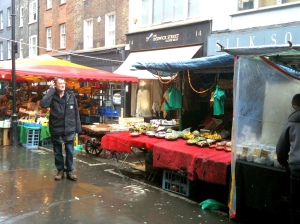Cada vez menos gosto de "planear" com muita antecedência o que vou fazer no dia a seguir. Claro que me refiro aos finais de semana, porque durante a semana, convém saber o que se vai fazer - minimamente - , pelo menos no local de trabalho. No entanto, também a esses "working days" podemos imprimir uma certa... incerteza nos acontecimentos "after-work".
Na noite de 6ª feira pensei qual dos (muitos!) mercados iria explorar pela cidade, este fim-de-semana. Queria ir a pé. Andar a pé em Londres é obrigatório. É a única forma de conhecer a cidade por "dentro", isto é, tonar-se familiar com as ruas, os pequenos cafés de esquina, o comércio de rua, as grandes cadeias de lojas, o trânsito frenético e os pequenos oásis que de repente surgem no meio da multidão tão multi-cultural. Também os sons são importantes para se deixar absorver por esta gigantesca cidade. O Mundo inteiro cabe aqui e para além do Inglês com variadíssimos sotaques, misturam-se todas as línguas que possamos imaginar. Uma Babel cosmopolita, electrizante e cativante ao ponto de nos deixarmos apaixonar por esta.
 Voltando ao meu fim-de-semana, em particular o meu Sábado... decidi que iria conhecer o mercado de Berwick Street. Conhecido não só pelo facto de ter sido capa de um dos mais conhecidos álbuns dos Oasis - What's the Story Morning Glory - , é um reconhecido mercado de legumes e frutas frescos e também frutos secos. Para além das tendinhas coloridas que se estendem pela pequena rua que dá nome a este mercado no coração do Soho, este é também famoso pelas suas lojas de música alternativa em Vinil (includindo Vinyl Junkies, CD City, Sister Ray, and Mr Bongo's).São já poucas, uma vez que a digitalização da música veio acabar um pouco com o negócio e apenas algumas se mantém graças à fidelidade de clientes que veneram o Vinil. Esta rua também alberga uma série de Estúdios e Agências de Publicidade, Lojas para Adultos e pequenos restaurantes e bares.
Voltando ao meu fim-de-semana, em particular o meu Sábado... decidi que iria conhecer o mercado de Berwick Street. Conhecido não só pelo facto de ter sido capa de um dos mais conhecidos álbuns dos Oasis - What's the Story Morning Glory - , é um reconhecido mercado de legumes e frutas frescos e também frutos secos. Para além das tendinhas coloridas que se estendem pela pequena rua que dá nome a este mercado no coração do Soho, este é também famoso pelas suas lojas de música alternativa em Vinil (includindo Vinyl Junkies, CD City, Sister Ray, and Mr Bongo's).São já poucas, uma vez que a digitalização da música veio acabar um pouco com o negócio e apenas algumas se mantém graças à fidelidade de clientes que veneram o Vinil. Esta rua também alberga uma série de Estúdios e Agências de Publicidade, Lojas para Adultos e pequenos restaurantes e bares.
Para os interessados em conhecer este pequeno "Oásis" de frutas e legumes frescos, o mercado está aberto de Segunda a Sábado, das 9:00 às 18:00.
Já agora... sabiam que a Berwick Street foi construída entre 1687 e 1703, sendo que o mercado surgiu no século XVIII? No entanto, este mercado só foi reconhecido em finais do século XIX?? Hummm.... será que na altura já existia a ASAE cá do brugo?! Fica a dica, e não, não é uma mentirinha para se contar a Turistas. ;)
Na noite de 6ª feira pensei qual dos (muitos!) mercados iria explorar pela cidade, este fim-de-semana. Queria ir a pé. Andar a pé em Londres é obrigatório. É a única forma de conhecer a cidade por "dentro", isto é, tonar-se familiar com as ruas, os pequenos cafés de esquina, o comércio de rua, as grandes cadeias de lojas, o trânsito frenético e os pequenos oásis que de repente surgem no meio da multidão tão multi-cultural. Também os sons são importantes para se deixar absorver por esta gigantesca cidade. O Mundo inteiro cabe aqui e para além do Inglês com variadíssimos sotaques, misturam-se todas as línguas que possamos imaginar. Uma Babel cosmopolita, electrizante e cativante ao ponto de nos deixarmos apaixonar por esta.
 Voltando ao meu fim-de-semana, em particular o meu Sábado... decidi que iria conhecer o mercado de Berwick Street. Conhecido não só pelo facto de ter sido capa de um dos mais conhecidos álbuns dos Oasis - What's the Story Morning Glory - , é um reconhecido mercado de legumes e frutas frescos e também frutos secos. Para além das tendinhas coloridas que se estendem pela pequena rua que dá nome a este mercado no coração do Soho, este é também famoso pelas suas lojas de música alternativa em Vinil (includindo Vinyl Junkies, CD City, Sister Ray, and Mr Bongo's).São já poucas, uma vez que a digitalização da música veio acabar um pouco com o negócio e apenas algumas se mantém graças à fidelidade de clientes que veneram o Vinil. Esta rua também alberga uma série de Estúdios e Agências de Publicidade, Lojas para Adultos e pequenos restaurantes e bares.
Voltando ao meu fim-de-semana, em particular o meu Sábado... decidi que iria conhecer o mercado de Berwick Street. Conhecido não só pelo facto de ter sido capa de um dos mais conhecidos álbuns dos Oasis - What's the Story Morning Glory - , é um reconhecido mercado de legumes e frutas frescos e também frutos secos. Para além das tendinhas coloridas que se estendem pela pequena rua que dá nome a este mercado no coração do Soho, este é também famoso pelas suas lojas de música alternativa em Vinil (includindo Vinyl Junkies, CD City, Sister Ray, and Mr Bongo's).São já poucas, uma vez que a digitalização da música veio acabar um pouco com o negócio e apenas algumas se mantém graças à fidelidade de clientes que veneram o Vinil. Esta rua também alberga uma série de Estúdios e Agências de Publicidade, Lojas para Adultos e pequenos restaurantes e bares.Para os interessados em conhecer este pequeno "Oásis" de frutas e legumes frescos, o mercado está aberto de Segunda a Sábado, das 9:00 às 18:00.
Já agora... sabiam que a Berwick Street foi construída entre 1687 e 1703, sendo que o mercado surgiu no século XVIII? No entanto, este mercado só foi reconhecido em finais do século XIX?? Hummm.... será que na altura já existia a ASAE cá do brugo?! Fica a dica, e não, não é uma mentirinha para se contar a Turistas. ;)











